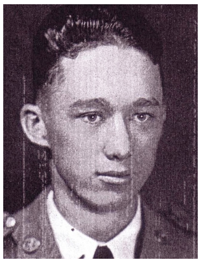Scroll of Honor – Oliver Jacob Rochester
From Teacher to Warrior
Written by: Kelly Durham
They were fighting over what in ordinary times would have appeared to be nothing more than a  worthless sliver of mango-covered coral, just two feet above sea level and only about five hundred feet wide. But in September 1943, Sagekarasa Island, resting along the southern shore of the Blackett Strait separating Kolombangara from Arundel in the New Georgia archipelago, was considered important terrain. Control of Sagekarasa and its neighboring Bomboe Peninsula would put US Army and Marine Corps forces within artillery range of the Japanese airfield at Vila.
worthless sliver of mango-covered coral, just two feet above sea level and only about five hundred feet wide. But in September 1943, Sagekarasa Island, resting along the southern shore of the Blackett Strait separating Kolombangara from Arundel in the New Georgia archipelago, was considered important terrain. Control of Sagekarasa and its neighboring Bomboe Peninsula would put US Army and Marine Corps forces within artillery range of the Japanese airfield at Vila.
Oliver Jacob Rochester of Salem, “Rock” as he was nicknamed by his classmates, studied agricultural education at Clemson. Although he served four years in the Corps of Cadets as a private, he nonetheless completed ROTC summer training at Fort McClellan, Alabama. Unlike many of the cadets from later classes who were summoned to service directly from campus, Rochester had already established himself in his career as a vocational agriculture teacher in Bunn, North Carolina by the time his orders arrived.
Rochester was called to active duty in February of 1942 as the United States, now at war, scrambled to deploy ground forces into combat theaters. Rochester, a member of Clemson’s Class of 1936, would be assigned to the 25th Infantry Division, the first Army unit to see action when its garrison at Schofield Barracks, Hawaii was attacked on December 7, 1941.
The 25th had been activated on October 1, 1941 as the United States prepared for the possibility of war. In December 1942,  it participated in the US counteroffensive on Guadalcanal, helping to deliver the first land defeat to the Japanese. In July 1943, after a period of rest and retraining, the division was deployed in the New Georgia campaign.
it participated in the US counteroffensive on Guadalcanal, helping to deliver the first land defeat to the Japanese. In July 1943, after a period of rest and retraining, the division was deployed in the New Georgia campaign.
On August 2, Rochester’s regiment landed on New Georgia. It attacked and captured Munda on the island’s southwest corner and then battled its way north. It moved by landing craft to Bomboe Peninsula and then crossed to Sagekarasa on September 14. The Japanese were using tiny Sagekarasa as a barge station from which to evacuate retreating troops across the Blackett Strait to larger Kolombangara and its important Vila airfield.
Keith Hook of Glastonbury, Connecticut, was a comrade of Rochester’s and recalled the operation in a 1999 letter to Rochester’s daughter Ellen. “We had established a block across the center of the island which was all jungle growth, mango trees,  coral rock, and a scattering of huge trees, and a lot of undergrowth. The island was only a couple of feet above sea level except for a small ridge running through the center. There were no clear areas except what we cut, although the Japanese had a trail going from one end of the island to the other.”
coral rock, and a scattering of huge trees, and a lot of undergrowth. The island was only a couple of feet above sea level except for a small ridge running through the center. There were no clear areas except what we cut, although the Japanese had a trail going from one end of the island to the other.”
On September 15, Rochester was killed in action. According to Hook, “The Japanese withdrew within a couple of days under our pressure and we secured Sagekarasa. Other 25th Infantry Division units landed on Kolombangara.”
Hook remembered Rochester as “a fine officer, a real gentleman, and well-liked by his fellow officers and his men.”
Rochester was survived by his wife Mary, his daughter Ellen, his parents, five brothers—two of whom were in the service—and a sister. In February 1949, First Lieutenant Rochester’s body was returned to Salem where it was buried in the Mountain View Wesleyan Methodist Church Cemetery.
For additional information on Oliver Jacob Rochester, visit:
http://soh.alumni.clemson.edu/scroll/oliver-jacob-rochester/
For more information about Clemson University’s Scroll of Honor, see:
http://soh.alumni.clemson.edu/scroll-of-honor/
